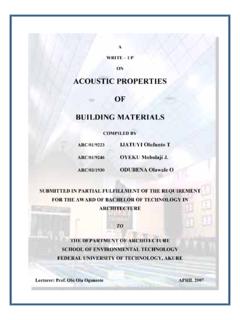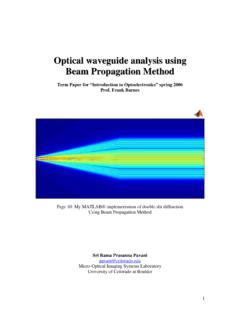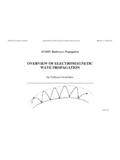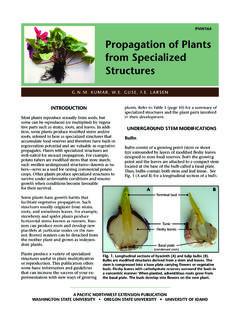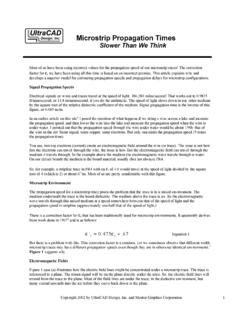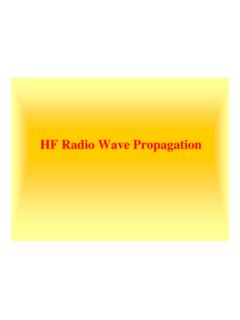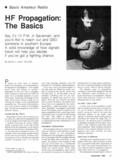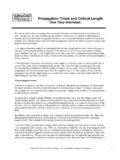Transcription of PROPAGATION OF SOUND - sdngnet.com
1 A WWRRIITTEE--UUPP On the PPRROOPPAAGGAATTIIOONN OOFF SSOOUUNNDD,, ITS TRAVEL PATH, TRAVEL MEDIUMS AND BEHAVIOR IN THE MEDIUMS. By AARRCC//0011//99220044 AAKKIINNAAYYOO,, OOlluuwwaaffiikkeemmii AARRCC//0011//99221122 AAYYAANNDDOOKKUUNN,, AAkkiinnsshheeyyee AARRCC//0011//99223333 OOKKAAHH--AAVVAAEE,, OObbuukkeennii Submitted to THE DEPARTMENT OF ARCHITECTURE School of Environmental Technology, Federal University of Technology, Akure, Ondo State. IN PARTIAL FULFILLMENT OF THE REQUIREMENT FOR THE AWARD OF BARCHELOR OF TECHNOLOGY IN ARCHITECTURE Supervised by Prof. Olu Ola Ogunsote. PROPAGATION OF SOUND 0 APRIL 2007.
2 CCHHAAPPTTEERR OONNEE SOUND AND ITS PROPERTIES IINNTTRROODDUUCCTTIIOONN What is SOUND ? SOUND is a disturbance of the atmosphere that human beings can hear. Disturbances produced by practically everything that moves, especially if it moves quickly or in a rapid and repetitive manner. SOUND waves: A wave is an oscillating disturbance that travels through a medium. Many forms of energy, including SOUND , travel in the form of waves. SOUND waves are longitudinal waves originating from a source and conveyed through a medium (gaseous, liquid or solid). When particles in the medium vibrate parallel to the direction the SOUND wave is traveling, we have a longitudinal wave. This is the type of SOUND wave produced by our transducers and used for medical diagnosis. In some materials, it is possible to transmit transverse waves, characterized by having the vibrations moving Figure 1; Longitudinal and transverse waves perpendicular (transverse) to the direction of wave travel.
3 Transverse waves travel horizontally (from left to right) - the vibration direction is perpendicular (at right angles) to the direction in which the wave travels or propagates. Waves in water and on strings are two good examples. PPRROOPPEERRTTIIEESS OOFF SSOOUUNNDD Speed of SOUND The speed of SOUND is a term used to describe the speed of SOUND waves passing through an elastic medium. The speed varies with the medium employed (for example, SOUND waves move faster through water than through air), as well as with the properties of the medium, especially temperature. The speed varies depending on atmospheric conditions; the most important factor is the temperature. Air pressure has almost no effect on SOUND speed. Air pressure has no effect at all PROPAGATION OF SOUND 1 in an ideal gas approximation, because pressure and density both contribute to SOUND velocity equally, and in an ideal gas the two effects cancel out, leaving only the effect of temperature.
4 SOUND usually travels more slowly with greater altitude, due to reduced temperature. Humidity has a small, but measurable effect on SOUND speed. SOUND travels slightly ( ) faster in humid air. The approximate speed of SOUND in 0% humidity (dry) air, in meters per second (m s-1), at temperatures near 0 C, can be calculated from: In general, solids will have a higher speed of SOUND than liquids, and liquids will have a higher speed of SOUND than gases. In general, the speed of SOUND c is given by Where: C is a coefficient of stiffness is the density Thus, the speed of SOUND increases with the stiffness of the material, and decreases with the density. Speed of SOUND in solids In a solid, there is a non-zero stiffness both for volumetric and shear deformations. Hence, in a solid it is possible to generate SOUND waves with different velocities dependent on the deformation mode.
5 In a solid rod (with thickness much smaller than the wavelength), the speed of SOUND is given by: Where: E is Young's modulus (rho) is density Thus, in steel the speed of SOUND is approximately 5100 m s-1. Speed of SOUND in a Fluid In a fluid the only non-zero stiffness is to volumetric deformation, (a fluid does not sustain shear forces). Hence, the speed of SOUND in a fluid is given by Where: K is the adiabatic bulk modulus PROPAGATION OF SOUND 2 The speed of SOUND in water is of interest to those using acoustics as a tool in the oceans or lakes, , for communication, mapping the ocean floor, or ocean acoustic tomography. In fresh water, SOUND travels at about 1435 m/s. In salt water, SOUND travels at about 1500 m/s.
6 The speed of SOUND in seawater depends on pressure (hence depth), temperature (a change of 1 C ~ 4 m/s), and salinity (a change of 1 ~ 1 m/s), and empirical equations have been derived to accurately calculate SOUND speed from these variables. Speed of SOUND in ideal gases and in air For a gas, K (the bulk modulus in equations above, equivalent to C, the coefficient of stiffness in solids) is approximately given by Thus Where: p is the pressure is the adiabatic index also known as the isentropic expansion factor. It is the ratio of specific heats of a gas at a constant-pressure to a gas at a constant-volume(C / Cpv), and arises because a classical SOUND wave induces an adiabatic compression, in which the heat of the compression does not have enough time to escape the pressure pulse, and thus contributes to the pressure induced by the compression. Wavelength of SOUND Wave The wavelength is the distance between two peaks, valleys, or any other corresponding points on the wave.
7 Wavelength is inversely related to the frequency. If, frequency doubles, wavelength halves. Figure 2; Diagrammatic representation of wavelength Frequency of SOUND Wave The frequency is the number of cycles of oscillation per second made by the SOUND source and the particles in the medium. The frequency of SOUND , has a standard formula; V = f Most SOUND waves that humans can actually hear, are frequencies from 20 20 000 Hz, 20 Hz would be very deep, low, rumbling sounds while 20 000 Hz would be a very high pitched, squealing noise. Audible SOUND frequency is called its pitch and expressed in "hertz." PROPAGATION OF SOUND 3 Amplitude of SOUND Wave The term amplitude refers to the amount of change of a time varying quantity.
8 The amount that the pressure increases (or decreases) in the medium as the SOUND wave travels through is called the Pressure Amplitude. Pressure amplitude is measured in units called Pascals (Pa) or Megapascals (MPa). Figure 3; Amplitude of SOUND waves Loudness of SOUND The loudness of a SOUND depends on the wave s amplitude. The louder a SOUND , the greater the amplitude. This is also a way of measuring the amount of energy the wave has. The system used to measure the loudness of sounds is the decibel system, given the unit dB. The decibel system is based on logarithms, which means for every step up by one, the SOUND is actually ten times louder. For example, a 15dB SOUND is ten times louder than a 14dB SOUND . The decibel is actually a fraction of a bel, the original unit for measuring SOUND (1 db = b). The "bel" was originally named after Alexander Graham Bell, the inventor of the telephone. Because the bel was too high a value for day-to-day situations, the decibel became a standard.
9 Power of SOUND Power refers to the rate at which energy is transmitted by the transducer. When considering the power from an ultrasound transducer we can think of it as the rate of energy flow over the entire beam. Power is given in watts (W) or in milliwatts (mW) Intensity of SOUND Intensity is defined as power per unit area. One can think of it as the rate of energy flow across a defined area of the beam. It is expressed in watts per square meter (W/m2) or in milliwatts per square cm (mW/cm2). Usually the power and the intensity are directly related. Doubling one doubles the other, and vice versa. In contrast, pressure amplitude and intensity are related through a square dependence. Specifically, the intensity, I is proportional to the pressure amplitude, A2. PROPAGATION OF SOUND 4 CCHHAAPPTTEERR TTWWOO PROPAGATION OF SOUND AND FACTORS AFFECTING IT PPRROOPPAAGGAATTIIOONN OOFF SSOOUUNNDD PROPAGATION of SOUND is the Transmission of Acoustic Energy through a medium via a SOUND wave.
10 SOUND is a sequence of waves of pressure, which propagates through compressible media such as air or water or solid. During their PROPAGATION , waves can be reflected, refracted, or attenuated by the medium. In air, SOUND is transmitted by pressure variations from its source to the surroundings. The SOUND level decreases, as it gets further and further away from its source. While absorption by air is one of the factors attributing to the weakening of a SOUND during transmission, distance plays a more important role in noise reduction during transmission. The reduction of a SOUND is called Attenuation. The effect of distance attenuation depends on the type of SOUND sources. Most sounds or noises we encountered in our daily life are from sources, which can be characterized as point or line sources. For a point source, the noise level decreases by 6dB per doubling of distance from it.
